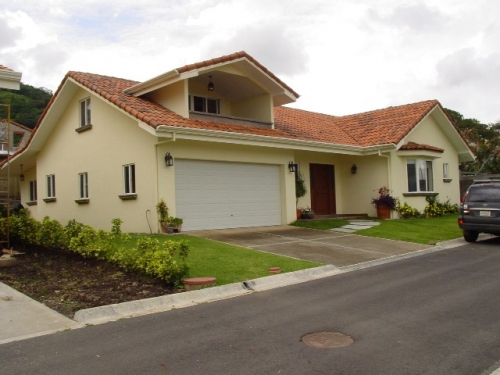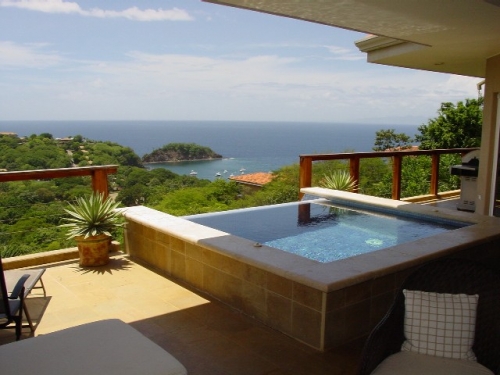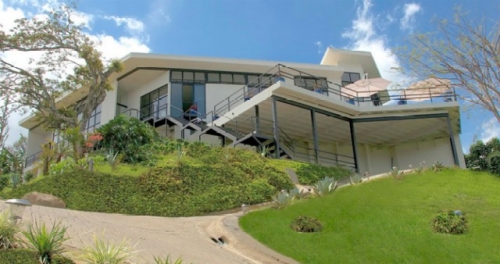Costa Rica Guide
Costa Rica Real Estate
List your property today!
Inclusion of real estate listings at Costa Rica Guide is
absolutely free of charge.
Featured Properties
Costa Rica Guide - Costa Rica Real Estate
Caribbean Region - Costa Rica Country Profile
From the canals of Tortuguero and the multi-colored sand beaches lined with towering coconut palms to the rugged mountains of Talamanca, adventure and discovery await all visitors.
Costa Rica’s Caribbean coast runs two hundred kilometers between Nicaragua and Panama extending inland as far as Braulio Carrillo National Park and narrowing in the south where the Talamanca mountain range sweeps toward the coast.
Typically different from the rest of the country, life in the Caribbean is a mixture of influences. Indigenous heritage combines with African, Oriental and Spanish bloods, offering as a consequence a rich combination reflected in spicy foods as well as "spicy" cultural expressions.
On the northern end of this zone is a long, straight coastal strip separated from the sea by a series of freshwater lagoons extending to Tortuguero and the Colorado River.
The city of Limon is capital of the province of the same name and marks the border between the north and the south. It is also the main port of access to the country on this coast and one of the preferred destinations for cruise ships navigating the Caribbean.
As an example of unique culture that reflects in language, food and dance, the Caribbean also offers world-class fishing, bird watching, horseback riding and all types of water activities including white-water rafting, ocean and river kayaking, first-class surfing and diving, snorkeling and canoeing. In the Talamanca region-yesterday’s land-add hiking and camping in uncharted wilderness and visits to various Indian reservations. In one word, "abundance".
The Atlantic slope is an area of great biodiversity that the country is endeavoring to retain through several protected zones. Perhaps Costa Rica’s most well known area is the northern coast where Tortuguero National Park and Barra del Colorado Wildlife Refuge protect a vast alluvial flood plain and the famous Tortuguero canals. A peaceful boat ride through these canals reveals abundant animal life and a multitude of birds in the exuberant foliage lining the waterways.
The fishing lodges of Barra del Colorado take advantage of the world-class tarpon fishing available in the area.
The beach at Tortuguero is the most important nesting site in the western Caribbean for the green sea turtle. The giant leather back and the hawksbill turtles also nest along these shores.
Puerto Viejo de Sarapiqui
A transitional zone located between the Caribbean and the Northern Plains, the Sarapiqui area however offers a better and quicker access through the Caribbean region. Puerto Viejo, the main village in the Sarapiqui area is located an hour and half from San Jose, on a paved road that leads through the Braulio Carrillo National Park then via Las Horquetas. The trip is very scenic.
The Sarapiqui river and others crawl sinuously across the landscape, vast sections are waterlogged most of the year and the water canals are still vital means of communication in the entire area.
Much of the area is still covered with tropical rainforest and several private reserves established in the area offer nature lovers a true paradise for birding and nature contemplation. Fishing is excellent in this territory, crocodiles and water birds abound along the water canals together with turtles, monkeys and sloths.
Several lodges scattered along the area offer the visitor excellent shelter, good food as well as knowledgeable guides from the zone in charge of making worth the visit to this territory that lies between the northern arm of the Braulio Carrillo National Park and NicaraguaÕs southern lowlands.
The village of Puerto Viejo is located in the confluence of the Sarapiqui and the Puerto Viejo rivers. In Costa Rica’s colonial times this river port due to its proximity to the San Juan river was the main shipping port. Nowadays, most of its income still comes from the river traffic.
Some of the attractions in the area for nature lovers are: Selva Verde, locted in Chilamate de Sarapiqui, a private reserve well known for its birdlife such as Oropendolas and others. La Selva Biological Station is another attraction. Managed and operated by the Organization of Tropical Studies (OTS). Located 2 miles south from Puerto Viejo, this reserve is particularly interesting due to the profuse birding life that protects through its 1,500-hectare extension. More than 420 species of birds have been identified. There are trails spreading along the reserve leading, to fantastic scenerarios suitable for research purposes or simply nature admiration.
Between beaches and forest reserves
If a stop in Limon produces a little culture shock, it’s a good equalizer for the journey ahead. Following the coastal road south of Limon quickly leads to the laid-back tropics envisioned in dreams.
A good paved coastal road leads south from the city of Limon to Cahuita and then to Puerto Viejo and Gandoca-Manzanillo. These are three fantastic beach areas where white as well as black sandy beaches enhance the rustic lifestyle of the wild Caribbean. The choice of where to play is up to you.
Small lodges and imaginatively decorated hotels are lined up along these beaches to welcome visitors. Time can be divided between beach relaxation, nightlife, surfing, sailing, fishing, hiking and much more. Cahuita National Park protects Costa Rica’s true coral reefs while Gandoca- Manzanillo Wildlife Refuge, a bit further south, is still very much a wilderness. Backed by the Talamanca mountain range, Cahuita, Puerto Viejo and Gandoca-Manzanillo are true sanctuaries for nature lovers and water sports fans.
An interesting thing about the Caribbean region is that visitors can easily move from a seashore landscape to forest reserves within a few kilometers and be sure that vegetation and landscape radically change.
Selva Bananito Private Reserve
One of the clearest examples of private efforts to preserve the beauty and the purity of nature in the Caribbean region is Selva Bananito, a private reserve located 15 kilometers inland from the coastal road leading to Cahuita.
The reserve is a family-owned farm encompassing 850 hectares of untouched vegetation. Bordering La Amistad Biosphere Reserve, the area is a sanctuary for bird and animal species located on the slopes of Cerro Muchilla. The reserve extends from 100 meters above sea level to 800 meters, assuring a variety of wildlife habitats. This "green belt" running from east to west in the southern part of Costa Rica is perhaps the largest unexplored territory in the country. It is a mystery indeed for scientists and a paradise for nature lovers.
Selva Bananito Lodge is built on a farm that belongs to the Stein family. Only one-third is used for farming, leaving the remaining land completely untouched. That one-third currently being exploited for farming purposes supports organic banana plantations and a cattle breeding program intended to produce dual-purpose breeds: cattle as useful for milk production as for meat.
Visiting Selva Bananito Lodge is a privilege that visitors shouldn’t miss while on the southern Caribbean coast. Lifestyle goes slowly but smoothly here. Food is a blessing and friendly conversation with other visitors sharing a common love for nature is something that stays with you once you leave.
Tortuguero National Park
There is only one thing in Costa Rica that can rival watching the mother sea turtle lay her eggs and that is getting to the nesting site. Tortuguero National Park is one of Costa Rica’s essential destinations. The wildlife is unsurpassed in its diversity and its plenitude.
Boats leaving from Freeman, a small river port a few miles before Limon, in the Bataan region, take visitors on the ride of a lifetime up man-made canals that have become home to hundreds of species of wildlife.
A trip through the canals is made more interesting as knowledgeable guides point out animals, birds and landmarks along the way.
Floating for nearly three hours through beautiful, serene canals, incredible quantities of birds and other animals exhibit their beauty and pride. Several types of monkeys, bats, wild parrots and toucans are evident and you can pass so close to crocodiles that you can see the brown stains on their teeth.
A daytime tour through the canals at Tortuguero reveals a multitude of wildlife and an abundance of verdant tropical vegetation. A hike to the summit of an ancient volcano, dormant for more than one thousand years, allows a chance for intimate contact with this natural zoo.
Tortuguero is an amazing destination in Costa Rica no one should miss. Hundreds of miles of untouched beauty await visitors at this aquatic park located along Costa Rica’s northern Caribbean coast.
One way or another, the contrasting Costa Rican Caribbean will indeed amaze you and perhaps will make you yearn to return as soon as you can. Just try it out and let us know.
The above information is courtesy of Costa Rica Institute of Tourism (ICT)






